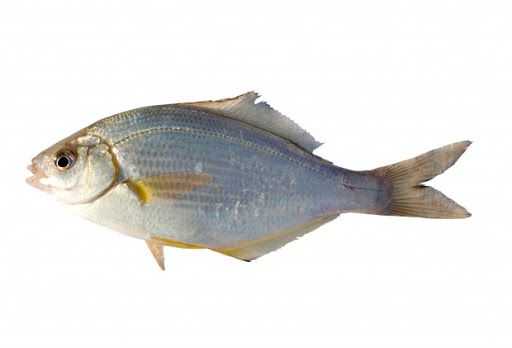White Seaperch

Species Details
Phanerodon Furcatus
Embiotocidae
Perciformes
Nearshore, Piers, Jetties
1 - 1 lbs.
8" - 15"
White Seaperch (Phanerodon furcatus) Fish Description
The White Seaperch (Phanerodon furcatus) is a member of the surfperch or Embiotocidae family commonly found in the waters of the southeastern Pacific Ocean. This fish closely resembles the pile perch with its highly compressed oval body, curving lateral line that runs from the gill to the tail, soft translucent fins, and the deeply forked tail. You can, however, tell this fish apart from the pile perch through its coloration that, as the name suggests, is a lot lighter than its brassy-brown close relative. The top part has a light olive color while the rest of its body is silvery white. The fins also have a lighter color with the base of the pelvic and anal fins having a yellow blotch. Lastly, the White Seaperch doesn’t have that distinguishing black spot on the cheek pile perch are known for.
The White Seaperch is a viviparous fish in that the females fertilize the eggs and develop the young internally and give birth to live ones. The females are also said to grow much larger and live longer than the males.
Diet and Size
The White Seaperch is a demersal carnivorous fish that is most active during the day. It often hunts for small fishes, fish eggs, shrimps, snails, crabs, brittle stars, bivalves, and even barnacles. The biggest ever caught was fifteen inches although most that are caught tend to be between eight to ten inches.
Interesting Facts
- The White Seaperch can grow as much as fifteen inches.
- White Seaperch is often seen schooling together with pile perch and black perch.
- They are sometimes called split tail perch because of their deeply forked tail fin.
- They are sexually dimorphic as the females tend to be bigger than males.
- Although the White Seaperch can yield a bit of usable meat, the taste is said to be quite bland.
- They are a popular target for recreational anglers because of their relative abundance near the shores.
- Most are often caught off piers, jetties, shorelines, and boats near the shore.
White Seaperch Fishing Tips
The White Seaperch is said to be not as notoriously picky as the pile perch even though they are often seen swimming together. That’s why this fish is easy to hook with whatever bait you might have with you. Just to be sure, though, most anglers who were successful in catching this fish have used live seaworms or shrimp; small strips of fresh fish and mussels are quite effective as well.
For the gear, the most common setup is a high/low leader with the number 6 or 4 hooks, a light line, and a light sinker. This will allow you to present two baits near the preferred habitat of this demersal fish, thus, doubling the odds of catching it.
Habitat and Distribution
The White Seaperch is found near the shores or in bays—often near piers, jetties, and docks with a sandy or rocky seafloor and quiet waters, where they tend to form small schools and often with other perches. They also prefer waters with temperatures of 50oF to 64oF and are found within shallow waters at depths of up to 280 feet.
The White Seaperch is endemic in the Pacific Ocean along the coastlines of Washington, Oregon, and California. They are most abundant, however, in the waters of Mexico, particularly along the shores of Tijuana to Guerrero Negro in Baja California.






